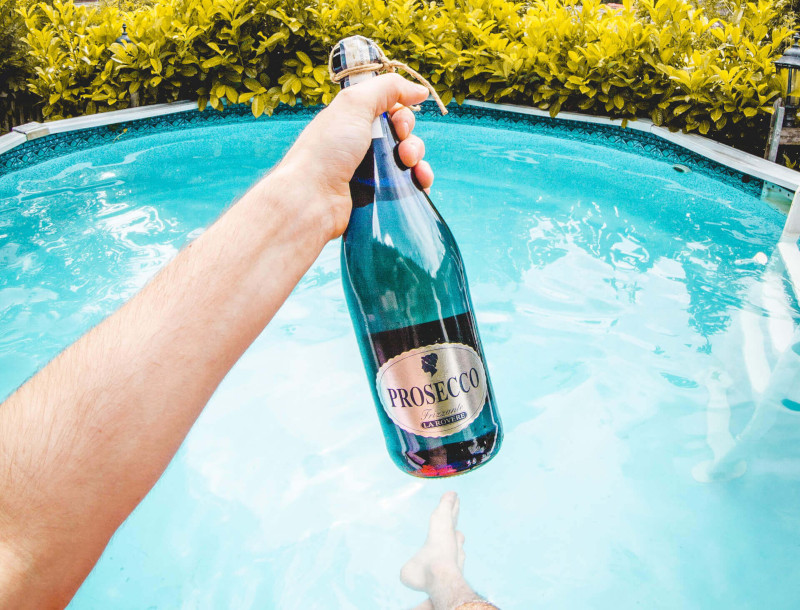In the world of effervescent beverages, Prosecco and Champagne are two of the brightest stars. But while they might look similar in your glass, these two sparkling wines have characteristics as unique as their regions of origin.
“Is it tomato, tomahto, or champagne?” says a curious novice at a wine-tasting event. In the vast vineyards of sparkling wines, terminology is paramount. While some may casually use ‘Prosecco’ and ‘Champagne’ interchangeably, they are distinct entities in the world of wine. Here’s how you can differentiate and choose wisely.
Spotlight on Prosecco
Originating from the picturesque Veneto region of Italy, Prosecco has carved a niche for itself in the sparkling wine domain. Glera, a grape type, is predominantly used in its making, constituting at least 85% of the wine. The Charmat method, or tank method, is employed to induce effervescence during its secondary fermentation. This method results in a wine known for its crisp, youthful exuberance. Given its nature, Prosecco is typically non-vintage, making it a blend of wines from multiple years.
“Its vibrant tones and freshness make Prosecco an instant hit for those looking for a lively drink,” notes an Italian sommelier.
Champagne’s Elegance

France’s northeastern Champagne region takes pride in producing the legendary sparkling wine – Champagne. Predominantly, it’s a blend of three grapes – Chardonnay, Pinot Noir, and Pinot Meunier. What sets Champagne apart is its production technique. The secondary fermentation occurs in the bottle itself, called the traditional method or “méthode champenoise.” This results in the wine maturing on lees, infusing it with an intricate texture, depth, and nuances of toastiness. While non-vintage Champagnes are more pocket-friendly, vintage Champagnes, made from grapes of a specific harvest, are seen as the luxe choice.
“Champagne offers a symphony of complex notes. Each sip can be an experience,” comments a French wine expert.
The Shared Charm: At the core, both Prosecco and Champagne provide a delightful bubbly experience. Both originate from Europe’s esteemed wine regions and have become household names. Yet, their individuality is as crisp as their effervescence.
Key Differences
When you pour them side by side, the differences become more palpable. Their birthplaces and the grapes used already set them worlds apart. The production techniques accentuate their uniqueness, influencing not just the bubble size but also their taste profiles.
If you were to zoom into the bubble size, Prosecco’s would be slightly larger, a direct influence of the Charmat method. On the palate, Prosecco shines with its zesty freshness. In contrast, Champagne, having spent time in oak barrels, introduces a broader palette, featuring hints of toast, spice, and creaminess.
- Origin & Grapes: The birthplaces of these wines are intrinsic to their identities. Prosecco owes its flavor to the Glera grape from Italy, while Champagne’s taste is attributed to a blend of grapes, primarily Chardonnay, Pinot Noir, and Pinot Meunier from France.
- Production Techniques: Prosecco and Champagne owe their effervescence to different fermentation techniques. Prosecco’s bubbles, a product of the Charmat method, tend to be more robust. In contrast, the traditional method employed in Champagne creation results in finer, more delicate bubbles, often referred to as a sophisticated mousse.
- Flavor Notes: While both wines can boast fresh fruit flavors, their aging processes diverge, leading to unique taste profiles. Prosecco shines with its vivacity and brightness. In comparison, the aging process Champagne undergoes adds layers, introducing hints of toast, spices, and cream.
- Aging Potential: The structure of these wines plays a pivotal role in their aging. Prosecco, with its zest, is best enjoyed young, typically within a few years of production. Champagne, possessing a more robust structure, stands the test of time while evolving and offering intricate tastes even after decades.
- Price Point: Economically, the intricate craftsmanship of Champagne does come with a heftier price tag when compared to the more accessible Prosecco. It’s generally positioned at a higher price bracket compared to the more economical Prosecco.
“The time and technique invested in Champagne give it a structural edge, making it apt for aging,” mentions a wine historian. Unlike Prosecco, which is best relished fresh, Champagne can evolve with time, enriching its taste. As for brands, Prosecco enthusiasts can look for names like Bisol or Sommariva, while Champagne lovers can choose between renowned Champagne houses like Krug or growers like Laherte Frères, who operate with the essence of a grower-producer. Here’s a breakdown of these brands and some others you can look out for, and where they can generally be sourced:
| Sparkling Wine | Top Brand | Average Price | Where to Source |
|---|---|---|---|
| Prosecco | Bisol | $15-$25 | Wine specialty stores, online wine retailers |
| Riondo | $10-$20 | Major supermarkets, wine shops | |
| Sommariva | $20-$30 | Online wine retailers, local wine boutiques | |
| Sorelle Bronca | $25-$35 | Wine specialty stores, online wine platforms | |
| Champagne | Krug | $200-$250 | High-end wine boutiques, online luxury wine retailers |
| Ruinart | $60-$100 | Major wine retailers, online wine shops | |
| Billecart-Salmon | $50-$80 | Wine specialty stores, online wine platforms | |
| Laherte Frères | $40-$70 | Local wine boutiques, online wine retailers | |
| Bérêche & Fils | $35-$60 | Wine specialty shops, online wine platforms |
Occasions and Serving Suggestions for Both Wines

When Should You Serve Them?
Prosecco: With its youthful exuberance and refreshing palate, Prosecco shines at laid-back gatherings. Picture sunlit afternoons with friends or colleagues at a backyard barbecue, family brunches with a spread of fresh fruit and pastries, or summer garden parties where light laughter fills the air. Its affable character aligns well with moments that don’t require gravitas but simply celebrate the joy of togetherness.
Champagne: Holding a reputation steeped in luxury and elegance, Champagne is the go-to for monumental occasions. Be it marking personal milestones like anniversaries, toasts at wedding receptions, or a sophisticated dinner with a significant client; its refined complexity mirrors the importance of these events. Also, ceremonial gatherings, where a significant achievement is recognized, often witness the popping of a Champagne cork, signaling celebration and achievement.
How To Serve Them
Prosecco:
- Temperature: Prosecco is best enjoyed at a cool 6-8°C (43-46°F). This temperature accentuates its crisp freshness.
- Glassware: A tulip-shaped glass is ideal. Its design allows the wine’s aromas to concentrate, enhancing the drinking experience.
- Pouring: To retain its effervescence, pour Prosecco gently down the side of the glass, tilting it slightly. This technique ensures minimal agitation and bubble preservation.
Champagne:
- Temperature: Serve Champagne at a slightly colder 5-7°C (41-45°F). Champagne must be at this temperature to maintain its fine mousse and nuanced aromatics.
- Glassware: A flute or a wine glass works best. While flutes showcase the wine’s bubbles beautifully, wine glasses allow the complex aromas of Champagne to breathe, enhancing its bouquet.
- Pouring: Like Prosecco, tilt the glass and pour Champagne gently down its side. Given its fine bubbles, this technique ensures they remain intact, offering that sought-after delicate mousse with each sip.
Prosecco or Champagne?
When looking for a bubbly that’s vivacious and wallet-friendly, Prosecco stands out. Its versatility makes it apt for casual soirées or even as a mix in cocktails. But if the occasion demands sophistication, or you’re keen on treasuring a bottle for the future, Champagne is the way to go.

